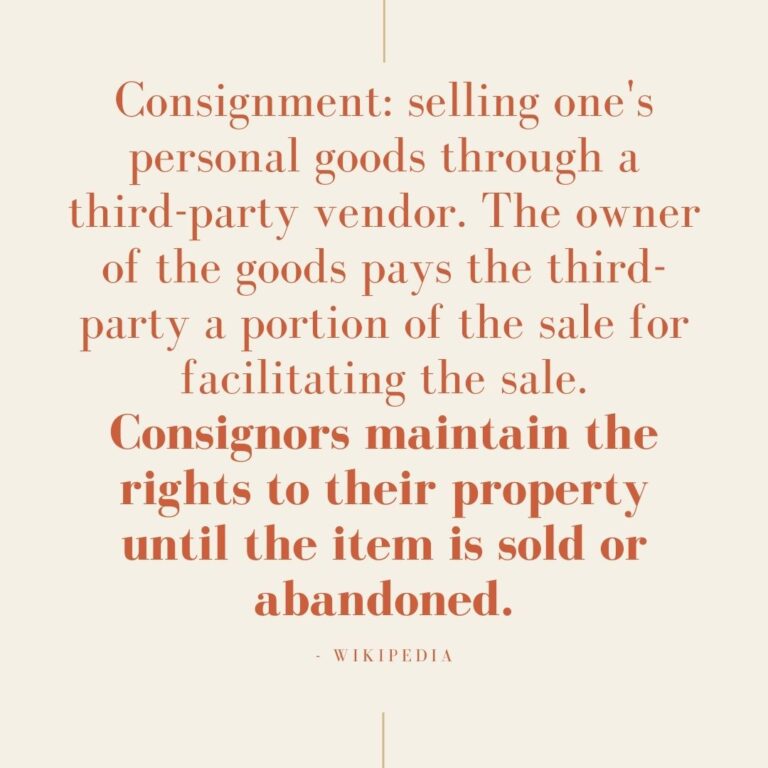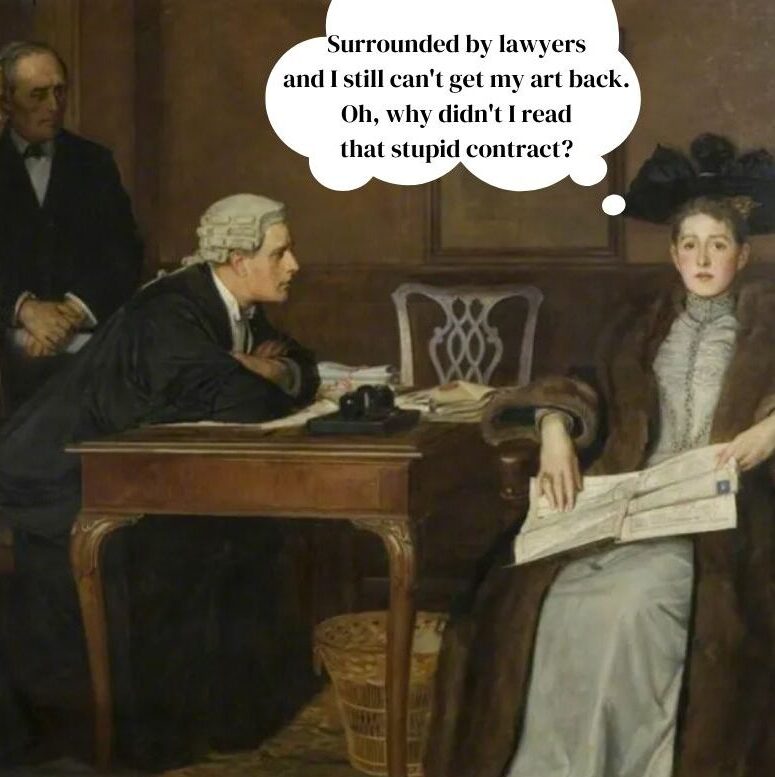In the art world, a lot of business is done on a handshake. Take consigning art to a dealer. Often there’s no actual consignment contract, just the good ol’ handshake.
What could possibly go wrong?
OK, let’s be honest. If and when presented with a contract, how many of you give it more than the cursory skim before signing?
Well, guess what? It's Your Lucky Day! Read on for some...

I work with a collector who happens to be a corporate lawyer. He’s hired me to help him rationalize his sprawling collection of paintings and prints by historic Colorado artists, and sell off what no longer supports the newly defined parameters. Kind of fun, actually, figuring out what stays and why and what goes and how and where to sell the items that don’t complete the story.
After three decades in the biz, I walked into this gig feeling confident in my knowledge of sales and consignment.
In actuality, it turns out that I–along with most of my peers–could use a brushing up on our legal rights and how to protect ourselves.
And so, in the spirit of helping artists and collectors avoid a little pain and suffering, I present to you:


The Consignment Loophole

In the process of moving a rather important and expensive painting through a dealer, my client–the guy who writes contracts for a living–set me straight on the law.
In a nutshell:
1. You do indeed hold title when consigning work to a dealer, with or without a consignment contract.
2. A consignment agreement is an important instrument that lays out the terms of consignment and is enforceable by law…most of the time.
3. Bankruptcy trumps consignment agreement.
4. You can’t squeeze blood from a turnip.
A truly terrifying case study
Stuff happens. The gallery gets hit with a lot of expenses during a slow month so they use funds from sales to keep afloat. They have every intention of catching up next month. But then a natural disaster hits or a viral infection rips through the entire world (just like Stephen King predicted in The Stand…but I digress), and business grinds to a halt.
Or you get sucked into a Ponzi scheme of epic proportions.
Thank goodness, dear Consignor, you have a contract and are, after all, the owner of your art, right? All you gotta do is just drive on down to the gallery and get your work back.
Uh, yeah, good luck with that.
Possession is nine/tenths of the law
Do you recall the 2007 Salander-O’Reilly Gallery bankruptcy? Here’s the Reader’s Digest version of what happened to one collector who got caught in the middle.
- Dr. Ronald Fuhrer, on behalf of the Kraken Foundation, consigned a painting, Sandro Botticelli’s Madonna and Child, to Salander-O’Reilly Gallery. Kraken was guaranteed a minimum payout of $8.5 million when the painting sold.
- Unbeknownst to Kraken, Lawrence Salander was about to be hauled off to jail by the Feds “in the midst of accusations of unpaid debts and fraud, including numerous instances of diverting the proceeds of works sold by the gallery, and the facts which came to light and eventually resulted in a criminal conviction of Mr. Salander.”
- Fuhrer, on behalf of the foundation, had signed a consignment contract with Salander BUT did not file a UCC-1 financing statement protecting their interest in the artwork. (More about this later.)
- Under the Consignment Contract with Salander, Fuhrer requested the return of the painting once the consignment period expired, but Salander did not comply.
Fuhrer went to court to sue for the return of the painting owned by Kraken Foundation AND…
Lost!

Learning the Hard Way
WHY: Bankruptcy court trumps a consignment contract. Fuhrer was denied the return of the painting, because it was deemed part of the sale that would be used to pay off Salander’s creditors.
THE LESSON: Had Fuhrer submitted a UCC-1 financing statement, which would have told the world he had an interest in the personal property of the debtor–in this case, Salander–he would have been first in line to get the Madonna and Child back.
UPDATE: After seven years and $2 million in legal fees, Fuhrer finally got the Botticelli back. Here’s a link to that story in artnet News: click here.
We Don't Need No Stinking Badges
OK, so now you know: in Bankruptcy, the law works to make third parties whole. But, artists, there’s some good news for you. Recently, laws have been put in place, state-by-state, to protect artists. Check with your state. Here’s Colorado’s law: Article 15-Consignment of Works of Fine Art.

COLLECTORS…
Sorry, but you don’t get the same consideration as artists under the law. That’s why you should file a UCC-1 financing statement. You also really, really, really need to know and trust any dealers you’re working with and have a good contract for all consignments.
I’ll give you details about what to include in a good consignment agreement right after one more scary story.
(It is almost Halloween, after all.)
The law protects the third party
I recently heard of a situation where a collector of rare, hand-made shotguns consigned one of his guns to a reputable dealer. When the seller learned his shotgun had sold and contacted the dealer to be paid, the dealer said he was very sorry but he had fallen on hard times and couldn’t pay up. He said he would try his best to make the consignor whole but….
The owner of the shotgun then said, “OK, just give me back my shotgun.” To which, both dealer and buyer said, “Nope.”
The seller has no legal recourse here. A “bonafide” purchaser bought in “good faith.” Title was transferred to the new buyer. The dealer could be sued, yes, but now we’re talking legal fees and small claims court. The shotgun is gone; the money spent.
Good luck squeezing blood from that turnip.
Elements of a Good Consignment Contract
ARTISTS: Check your state’s laws to see what protections are in place already. Here’s that link to Colorado’s statute: Consignment of Fine Art.
- Financials: terms of sale, terms of payment (how long before you get paid), sales percentage splits, length of contract.
- Advertising and promotions: what’s the split of costs, if any, between artist and gallery/dealer. What kinds of promotions will the gallery do and what are the expectations on the artist?
- Discounts: do you, the artist, allow discounts, and, if so, how much is allowed? Do you need to approve all discounts offered to clients by the dealer or will you allow them to decide up to a certain amount?
- Insurance: at what point does the gallery take over insuring the art, and make sure it’s insured in transit, when, for example, the dealer sends things out on approval.
- Exclusivity: what amount of territory does your dealer have exclusive rights over. What happens if work sells within that territory, say at a fundraising event in the same city as your gallery? Does the dealer want to restrict you from selling work out of your studio or will you need to give them a cut of the sale?
- Framing: is the expectation that all work be framed or can some work come in unframed? If the gallery frames the work, what are the expectations of splitting the costs or the gallery recouping cost upon sale or return to artist?
- Need a contract? Consider reaching out to Colorado Attorneys for the Arts (CAFTA), a pro bono legal referral service connecting artists, performers, cultural organizations and creative business to volunteer attorneys. CAFTA also offers educational presentations, webinars and resources. Click here: CAFTA
Additional thoughts for Collectors
COLLECTORS: File a UCC-1 financing statement, which is a legal notice filed by creditors in an effort to publicly declare their right to seize assets of debtors who default on loans. Here’s a link to the form: UCC-1.
Include elements above and add:
- That you maintain a “purchase money security interest and first priority lien in and against the Artworks to secure the payment of the purchase price.”
- Agree on purchase price or percentage of commission for the sale. Consider whether you want a specific amount–the dealer will then add to that price the amount he needs to make on the sale. Or you can agree on a percentage that the dealer will make regardless of the selling price.
- Who pays taxes on the sale–the dealer should but I’ve seen contracts that indicate that the consignor is/may be responsible. Best to spell that out.
- Shipping and handling–decide who pays and how the work will be handled when out of your control.
- Expenses associated with the sale of the art. Sometimes with resales there are condition issues that have to be addressed with a conservator. Determine who pays for what and make sure you are notified of the issues and what needs to be done BEFORE the work is done. Reframing, condition reports, and appraisals are other cost that might crop up; think about how these should be handled and make sure you are notified before anything is done.
The Bottom Line
It doesn’t matter how airtight your contract is if you can’t trust the person with whom you’re doing business. So, do your homework and ask around before entering into any agreement.
And remember, the art world is very, very small.

6 thoughts on “Laying Down the Law”